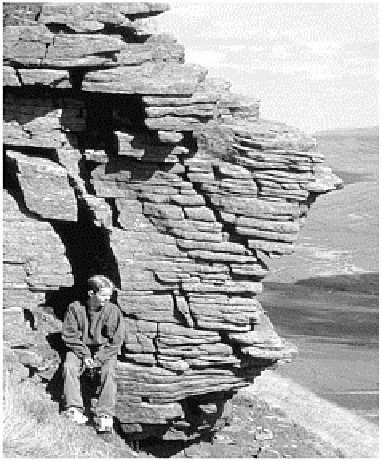Environmental Engineering Reference
In-Depth Information
Plate 12.2
Namurian Millstone Grit exposed in a valley-side
tor on Pen-y-Ghent, western Yorkshire Dales. Near-
horizontal and cross-bedded structures in these deltaic
sediments of Carboniferous age have been exploited by
Pleistocene frost weathering.
Photo: Ken Addison.
product of specific environmental processes in a broader landsystem and constitutes a
sedimentary facies
. A facies may vary as much internally as it does from adjacent facies.
It is said to be a
litho
facies or a
bio
facies, depending on whether
minerogenic
(inorganic)
or biogenic constituents predominate, and their characterization is the first step in
reconstructing their environmental origins. Each facies is the stratigraphic equivalent of a
sedimentary landform and may represent a single event. Contemporary geological or
geomorphic processes are present at the surface, burying older ones in the stratigraphic
record (Plate 12.3).
Facies assemblages linked by common genetic origins constitute a
sedimentary
environment
whose terrestrial form corresponds very closely with the
geomorphic
landsystems
described in later chapters (Figure 12.14). Moreover, the global location of
major sedimentary environments is determined largely by plate tectonics, which create
sedimentary basins
at specific locations. They collect the sedimentary signature of
volcano-tectonic, denudation, climatic and biological processes operating there (Figure
12.15). The principal endogenetic basins are subduction trench and arc basin systems;
continental, mid-ocean and aulacogen rifts; and passive-margin shelf and continental
subsidence basins. Exogenetic processes cut valley floors and fill lake basins on a smaller
scale. Sea-level

